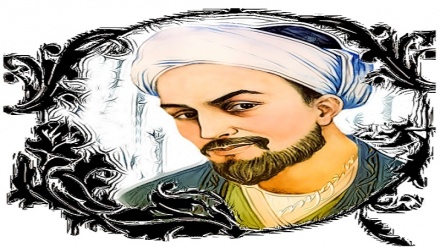Iranian notables, sources of global honor (204)
If you remember, for a couple of weeks we have been discussing the life and works of the famous poet of 6th and 7th century AH (12th and 13th century AD), Owhad-eddin Hamed ibn Abi-l-Fakhr Kermani. We said there is little information on the life and times of Owhad-eddin Kermani as chroniclers and biographers have written very little about him. The only sources for knowing him are the account of Mohye-ddin al-Arabi in Futuhat Makkieh and the book “Manāqeb” whose author is not known.
We also said that he had left Kerman due to the onslaught of Ghaz Turks and their dominance on the region. Researchers maintain that he was born in Zil-Hijja of 561 AH and died in Sha’ban of 635 AH in Baghdad. In the beginning of his trip he had gone to Baghdad and studied there and became the teacher of Hakkakieh school there.
Owhad-eddin Kermani didn’t believe Sufi Sheikhs; hence he spent most of his time in seclusion living as an ascetic to expurgate his spirit and heart. One day he passed by the Khanqah of Rokn-oddin Mohammad Sojāsi, a renowned Sufi of those days. Sojāsi was from Sojās village near Zanjan in Northwest of Iran. His Khanqah was beside River Tigris.
Owhad-eddin was appointed by the Abbasid caliph as the master of Sheikhs in Baghdad and stayed there till the end of his life.
Generally speaking, a Khanqah is different from a school. At school, teachers used to teach a set of logical concepts and arguments so that their students would learn that the fact is what they have understood. Accordingly, these students would be confined to the teachings of the predecessors and would rarely think of creativity and innovation. But the instruction was different in a Khanqah. Over there, a Sālek (seeker and traveler of the path of truth) would be trained in a way that he would gain a novel method of thinking to look at the world inside and outside in a different way. This educational method would cause the student to march in a new path and ignore imitation. He would become creative to discover the truth personally. In the view of late Professor Badi’uzzaman Foruzanfar, “That’s why, during the time that the education of Khanqah was based on correct principles, the travelers of the path [the students] were not the imitators of their masters and leaders; and they had different opinions from them.”
History bears witness that Rokn-oddin Mohammad Sojāsi had trained his pupils in this way. This can be confirmed by two of his prominent pupils, namely, Owhad-eddin Kermani and Shams-eddin Tabrizi who devised new ways ahead of the seekers of truth.
One of the principles that Owhad-eddin used to adhere to was the veneration and worship of beauty. Worship of beauty is a deep-rooted concept in Sufism. Abu Helman, who lived in the 3rd century AH, was famous in this method. This group of Sufis maintained that worship of beauty can soften the feeling and moderate the morals. This was the belief of some of the Sufi masters about music and Semā’. They opined that music and Semā’ can cleanse and illuminate the heart and make it capable of reaching God as the ultimate Truth. Owhad-eddin was an adherent of this school of Sufism. That’s why some of his contemporaries excommunicated him as a disbeliever. Of course, the life of Owhad-eddin proves the opposite.
Owhad-eddin Kermani didn’t separate worship of beauty from worship of God. He believed that human being has no other choice but the existing tools and phenomena to perceive reality and find his way towards the Truth and the divine love. He says:
زآن می نگرم به چشم سَر، در صورت کز عالم معنیست اثر در صورت
With these very eyes I behold the image,
‘Cause supernatural is mirrored in the image.
این عالم صورتست و ما در صوریم معنی نتوان دید مگر در صورت
An image is this world; in images are we,
Supernatural cannot be seen but in the image.
Late Foruzanfar maintained writes, “The popularity of Owhad-eddin among masses and his appointment as the master of the Sheikhs in Baghdad by the caliph; and enjoying noted successors indicate that he had pure love and intention. In Semā’, too, many of the elderly Sufis complied with him and considered it as a kind of worship.”
Owhad-eddin was of the opinion that the Beloved (God) is manifested in the entire universe. He deemed beauty as a manifestation of the spiritual and supernatural world and looked at that world and its beauties through beholding the beautiful face image.
Jan (Yan) Rypka, Czech Iranologist, says, “This group of Sufis considered glorification of celestial beauties can materialize through glorification of terrestrial beauties.” Some researchers believe that this is a kind of Humanism that had emerged in the Islamic mysticism and Sufism for a certain period. This had apparently led to the notion of “Perfect Man”, because beauty is perfection by itself. The method of seeing and extolling of beauties was not a novel method. In fact, it had culminated in the era of Owhad-eddin. This group maintained that since the servant (of God) reaches the stage that God is manifested in his eyes, ears, tongue and heart, whenever he looks it is God who looks and God sees His beauty in the beauty of the lookers.
RM/ME


